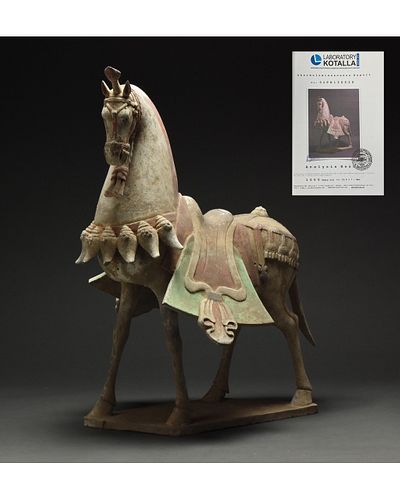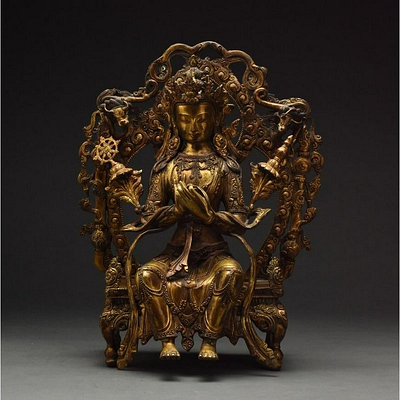LARGE NORTHER WEI DYANSTY TERRACOTTA HORSE - TL TESTED
Lot 108
Categories
Estimate:
GBP£6,000 - GBP£8,000
$8,108.11 - $10,810.81
Absentee vs Live bid
Two ways to bid:
- Leave a max absentee bid and the platform will bid on your behalf up to your maximum bid during the live auction.
- Bid live during the auction and your bids will be submitted real-time to the auctioneer.
Bid Increments
| Price | Bid Increment |
|---|---|
| GBP£0 | GBP£1 |
| GBP£10 | GBP£5 |
| GBP£100 | GBP£10 |
| GBP£200 | GBP£20 |
| GBP£500 | GBP£50 |
About Auction
By Apollo Art Auctions
Jul 26, 2020
Set Reminder
2020-07-26 08:00:00
2020-07-26 08:00:00
America/New_York
Bidsquare
Bidsquare : ART OF ASIA- FROM ANTIQUITY TO PRESENT DAY
https://www.bidsquare.com/auctions/apollo-art-auctions/art-of-asia--from-antiquity-to-present-day-5317
We are members of the BNTA (British Numismatic Trading Association) and the ALR (Art Loss Register). WE ACCEPT DIRECT PAYMENTS IN ALL MAJOR CURRENCIES: BIDDERS CAN PAY IN USD, GBP AND EUR. NO RESERVE SALE IN-HOUSE PACKING AND WORLDWIDE SHIPPING FOR ALL LOTS. Apollo Art Auctions enquiries@apolloauctions.com
We are members of the BNTA (British Numismatic Trading Association) and the ALR (Art Loss Register). WE ACCEPT DIRECT PAYMENTS IN ALL MAJOR CURRENCIES: BIDDERS CAN PAY IN USD, GBP AND EUR. NO RESERVE SALE IN-HOUSE PACKING AND WORLDWIDE SHIPPING FOR ALL LOTS. Apollo Art Auctions enquiries@apolloauctions.com
- Lot Description
Ca. 386-534 AD. Chinese Northern Wei Dynasty. Terracotta Horse. A heavily restored, elegant hollow-moulded terracotta horse. This horse is modelled in a standing pose with its neck elegantly arched and its ears pricked forward attentively. The tail is depicted free flowing, instead of bound in the traditional military fashion. Taken together with the elaborate trappings which are modelled in great this terracotta may represent a horse fitted out for parade. The white slip remains, with additional pigments, such as orange and black and green, used to pick out details of the features, such as the trappings, the blanket and the muzzle. Horses were an important status symbol in ancient China. These animals were brought to China via the Silk Road and were considered a luxury good. As such horses were a sign of wealth among the elite, and there were strict laws which restricted the ownership of horses to people of elevated rank. In fact, soldiers serving in China’s military had to provide their own mounts indicating that only the richest members of society could serve in the cavalry. This exceptionally well-preserved terracotta is part of a long tradition of horse statuettes in China, and in fact, the earliest known example of a stirrup, today a mainstay of equestrianism, was found on another Chinese statue of a horse from Hunan province, dated to AD 302 (see Cartier, M. 1993. ‘Considérations sur l'histoire du harnachement et de l'équitation en Chine.’ Anthropozoologica, 18, 29-44). Excellent condition. Authenticated by Ralf Kotalla laboratory in Germany; report attached. Provenance: From an old British collection formed in the 1990s; Size: H:680.5mm / W:520.5mm ; 15kg
- Shipping Info
-
We offer in-house packing and international shipping at discounted rates.
-
- Buyer's Premium



 EUR
EUR CAD
CAD AUD
AUD GBP
GBP MXN
MXN HKD
HKD CNY
CNY MYR
MYR SEK
SEK SGD
SGD CHF
CHF THB
THB



















